Walter Horace Carter
was born on January 20, 1921, in a small house owned by the
Efird Cotton Mill on the corner of Church and Mill streets
in Albemarle, North Carolina. Both of his parents then worked
at the mill, as Carter himself would later, and he eventually
adopted many of their most fundamental beliefs as Southern
Baptists. “Both sides of my parents’ families,
the Carters and the Lowders, were real prohibitionists,”
Carter later wrote, “sincerely believing that drinking
alcohol, any alcohol, was sinful and would surely send you
to hell. It was never found in our house.”
Growing up in Endy
Horace Carter moved with his family at the age of 3 to a
house built by his father in Endy, North Carolina, a small
community just outside of Albemarle. It was here, in the
rural countryside of Stanly County, that young Horace fished,
hunted, Horace Carter, left, and his brother, Mitchell
and attended the Endy School. It was not the kind with the
Endy School in the background
of a background one might expect of a future Pulitzer
Prize winner. As Carter himself later explained:
|
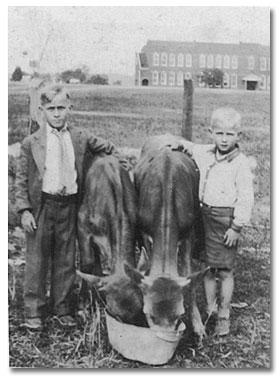 |
|
Horace Carter, left, and his brother, Mitchell
with the
Endy School in the background |
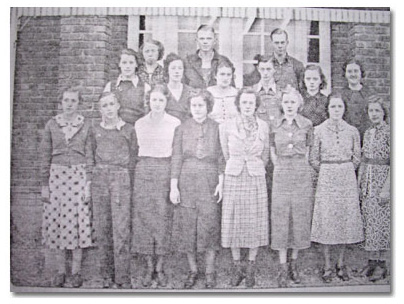
|
“Born in poverty
of wonderful, but uneducated, parents; growing up in a rural
community where every family either eked out a living on
a tiny farm or else commuted to the county seat to work
in the cotton mills for thirty cents an hour; attending
schools where some of the teachers had never even gone to
college, how could I expect any success in life? I was a
runt, the smallest student,
The senior class of Endy High School , 1939. Carter is on
the front row, in my classes (including
second from left the girls), too small to play basketball,
and no football team even to try out for. Not one boy from
Endy High School had ever gone to college and graduated.
Only one girl had.”
What Horace Carter did have was the encouragement of his
English teacher at Endy, Mrs. F. B. Hartsell. Hartsell inspired
Carter to pursue his aptitude for writing, and during his
last two years at Endy High School (1937-39) he wrote a
column on school news for the local newspaper, the Stanly
News and Press.
|
|
The senior class of Endy High School, 1939. Carter is
on the front row,
second from left |
Journalism and the Navy at UNC
|
After saving almost everything he earned from his mill
and newspaper jobs, Horace Carter entered the University
of North Carolina at Chapel Hill in 1939—with only
$112 to his name. The “people’s University”
helped him out, however, with a work study job at UNC’s
news bureau, and by the time the United States entered World
War II in 1941, Carter was a junior in the university’s
School of Journalism.
He was also anxious to support the war effort,
and in January 1942, he left Chapel Hill to work in the
busy shipyard at Wilmington, North Carolina. Enlisting in
the Navy the following August, Carter advanced through a
series of assignments in Virginia, South Carolina, and Florida
before returning to UNC late in 1943 as part of the Navy’s
V-12 training program.
Horace Carter was elected editor of UNC’s semi-weekly
student newspaper, the Tar Heel, in April 1944, and during
his brief tenure as editor he learned as much about the
duties and responsibilities of a journalist as he did about
the mechanics of putting out a paper. As Carter later recalled, the president of UNC, Dr. Frank Porter Graham, was one of his most important teachers. "When I got to be the editor of the Tar Heel, every Sunday night, I'd go to Dr. Graham's house and we'd talk about campus problems and the things the newspaper ought be writing about." One of those things was racial
prejudice. “I
had maybe some of that prejudice ‘til I was 18 or
19 years old,” Carter explained. “But I never
had any prejudice against blacks after I met Doctor Frank
Porter Graham. And he was one of my three idols . . .”
|
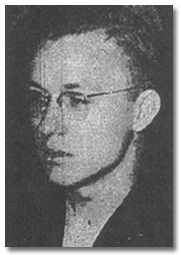
Horace Carter as editor of the Tar Heel, 1944 |

|
Three months after his election as editor, Carter was transferred
by the Navy to midshipman’s school at Notre Dame University
in South Bend, Indiana. There, Carter continued to hone
his skills as a journalist, serving as editor-in-chief for
the Navy’s yearbook, The Capstan. He also volunteered
for a special forces training program in Florida called
“Scouts and Raiders.”
Before beginning his training in Florida, however, Carter
married his fiancÚ of several years, Lucile Miller. "Cile,"
as he affectionately called her, was the daughter of a dairy
farmer near Richfield, North Carolina. She was also a recent
graduate of Appalachian State College in Boone, North Carolina,
and teaching elementary school in Gastonia, North Carolina,
at the time of their marriage in October 1944.
Horace Carter entered the special forces program but night
blindness and leg injuries soon ended his training with
the Scouts and Raiders. From Florida he was sent to navigator's
school in Brooklyn, N.Y. and then on to the USS Zenobia, a Navy
transport vessel, where he served until completing his naval
duties on January 28, 1946—the same day his wife gave birth
to their first child, Linda.
|

Lucile Miller and Horace Carter on their wedding day |
Pursuing journalism as
a profession
The young veteran also enrolled simultaneously at UNC,
with the purpose of completing his degree in journalism,
but then set aside those plans after accepting a position
as executive secretary of the merchants association in Tabor
City, North Carolina. Closely tied to his acceptance, moreover,
were the related plans of local merchants to help him start
a newspaper in Tabor City. And on July 5, 1946, just weeks
after he and his family moved to Columbus County, Horace
Carter published the first edition of the Tabor City Tribune a
weekly newspaper he edited and published.
Unable to afford printing equipment of his own, Carter
relied at first on the presses that belonged to James Lee
Platt, a lawyer who owned the Mullins Enterprise in Mullins,
S.C., some twenty miles south of Tabor City. Platt exacted
a heavy price from Carter for the job: one-half of the Tribune’s
gross advertising revenues.
Carter resigned from the merchants association to focus
on his newspaper. “‘In the beginning, God created—’,”
Carter wrote in his first editorial, “and so goes
the Bible. And here is the beginning of a newspaper designed
to live and serve the peoples of all races and colors living
in the area surrounding Tabor City with special emphasis
on Columbus county, N.C., and Horry county, S.C.”
Horace Carter was succeeded at the merchants association
by an older, more experienced journalist, North Carolina
native Willard Cole. The two men worked closely together
until the summer of 1947 when Carter leased the Tribune
and moved to Chapel Hill. Although Cole continued to work
for the merchants association in Tabor City, he was soon
hired as editor of the Whiteville News Reporter,
a twice-weekly newspaper just twenty miles away.
|
In the meantime, Carter returned to Chapel Hill to partner
with Orville Campbell in a new printing company, Colonial
Press. Both men had served as editor of the Tar Heel and
both were Navy veterans. They had also dreamed of starting
a newspaper together following the war. What brought them
together again in Chapel Hill was the contract for printing
the student newspaper, the Tar Heel. Campbell received the
contract and Carter agreed to return to Chapel Hill to help
him print the paper.
Over the next three years, Carter completed his degree
in journalism at UNC and Lucile gave birth to their second
child, a son they named Russell Miller Carter in honor of
her family and UNC journalism professor, Phillips Russell.
It was also during this time that Carter hatched a business
plan with another graduate of UNC's School of Journalism,
Mark Garner.
|
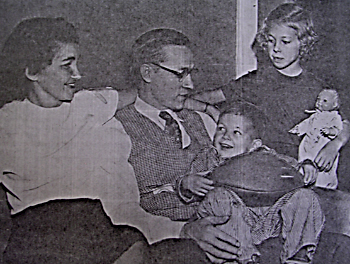
Horace Carter with daughter Linda, wife Lucile, and young
son Rusty |
A new partner and a new company
Marcellus Craig Garner was a native of Meridian, Mississippi,
who had graduated from high school in Asheville, North Carolina,
before taking his degree at UNC and serving as a combat
correspondent during World War II . A veteran of the Army
Air Corps, he had returned to Asheville to work as a sportswriter
and as assistant manager of the local chamber of commerce.
In 1948, however, Garner had moved to South Carolina to
become executive secretary of the Myrtle Beach Chamber of
Commerce, and by 1949, he was convinced that the booming
South Carolina resort (located just 30 miles from Tabor
City) could support another weekly newspaper to compete
with the Myrtle Beach News, a struggling tabloid
recently purchased by James Lee Platt.
Horace Carter agreed with Garner's assessment, and
together they formed the Atlantic Publishing Company, Inc.
The new company was designed to own and print both the Tabor
City Tribune and a new newspaper, the Myrtle Beach Sun.
Carter received a linotype and other equipment as his share
of the Colonial Press partnership with Orville Campbell,
and he and Garner capitalized their new venture with funds
Carter had saved from his Navy pay; with a personal loan
to him from Loris, S.C. Chevrolet dealer Eldred Prince;
and with funds Garner received from the sale of real estate.
|
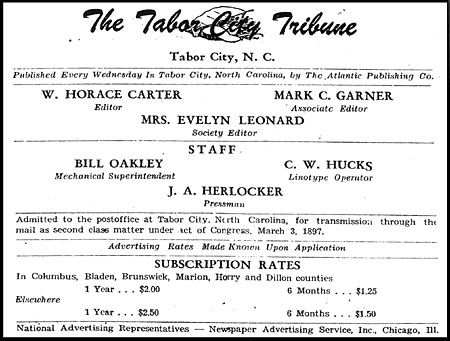 |
Carter returned to Tabor City with his family, and on June
14, 1950, the Tribune announced that it was now
owned and printed by Atlantic Publishing and that Carter
would be the paper’s editor and publisher. Two days
later, on June 16, the first issue of the Myrtle Beach
Sun hit the stands, with Mark Garner as its editor.
Carter and Garner would continue as partners for almost
a decade, and during that time, they would run their respective
papers according to their original plans: without any interference
from the other. Though the boosterism of place pervaded
both papers, particularly in the promotion of economic development,
it was always strongest at the Sun. “The
Sun is founded on faith—faith in the future of
Myrtle Beach,” Garner wrote in his first editorial.
“The rate of Myrtle Beach’s growth in recent
years is phenomenal. Our confidence that this development
will continue at an accelerated pace is evidenced by this
issue of The Sun.”
|
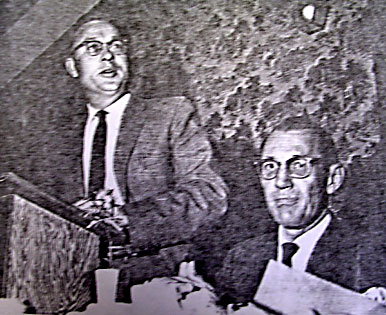 |
Garner never described the Sun, however, as Carter
had described the Tribune, as a newspaper designed to serve
“peoples of all races and colors” in the border
region that both papers called home. Nor did Garner concern
the Sun with the “hard news” and controversies
that Carter carried and confronted in the Tribune.
Garner used the Sun instead to “present the
considered opinions of its editors on non-controversial
issues of general interest to the community in which it
operates. In politics,” Garner wrote, “The
Sun is and will remain under this editor, an independent
Democratic publication.”
|
Horace Carter,
standing, with Mark Garner, seated |
Confronting the
Klan
Nowhere were the differences between the two papers more
apparent than in their responses to the Ku Klux Klan uprising
of 1950-52. While Carter challenged the Klan, Garner chose
not to. On Saturday night, July 22, 1950, the Ku Klux Klan
began a recruiting drive in Tabor City, N.C. A motorcade
of some 30 vehicles—most bearing South Carolina license
plates and each carrying several robed and hooded klansmen—snaked
slowly through Tabor City's black neighborhood before winding
its way through the crowded streets downtown. Though no
violence occurred, klansmen handed out membership forms
and scattered leaflets from their passing vehicles.
Carter responded four days later, in the next issue of
the Tribune, with “An Editorial: No Excuse
for KKK.” It was the first of many anti-Klan editorials
that he would write over the next two years and that eventually
won him a Pulitzer Prize for Meritorious Public Service.
One month later, on August 26, an even larger Klan motorcade
cruised through Myrtle Beach, Atlantic Beach, and Loris
S.C. Leading the procession was the same klansman who had
organized the motorcade across the border in Tabor City,
the Grand Dragon of the Association of Carolina Klans, Thomas
L. Hamilton.
This time, however, there was violence. Klansmen attacked
and shot up Charlie’s Place, a popular black nightclub
at Myrtle Beach, and then seized and severely beat the club’s
black owner, Charlie Fitzgerald. Significantly, the only
participant who died that evening was a white policeman,
James Daniel Johnston of Conway. Recently elected as a magistrate
of the town, Johnston died after being shot in the back
at Charlie’s Place, his Klan robe covering his policeman’s
uniform.
|
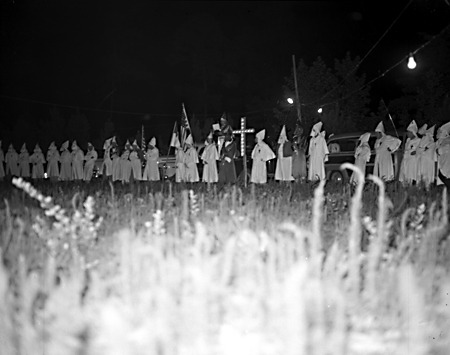
The Association of Carolina Klans flourished in Columbus (N.C.) and Horry
(S.C.) counties between 1950-52.
(Reprinted with permission of The News & Observer
of Raleigh, North Carolina.) |
In addition to front-page coverage in the Sun, the incident
drew “An Editorial” from Garner in an adjacent
column. The young editor blamed neither the Klan nor its
actions for the violence. “The nationwide black eye
Myrtle Beach wears this week will heal with time,”
Garner predicted. “A thick beefsteak in the form of
favorable publicity in the future will see to that.”
What the “unpleasant event” had done, Garner
believed, was “shock the thinking people of this city.”
His advice for them to ponder? Luke 6:31: ‘Do unto
others as you would have them do unto you.’ And he had nothing more
to add over the next two years, as the Klan continued its
activities in Horry County, S.C., and Columbus County, N.C
|
Horace Carter later explained Garner’s
reluctance to join him in crusading against the Klan. “He
and I discussed this many times,” Carter said, “because
the Klan was just as active in Myrtle Beach as it was in
Tabor City. But he [Garner] just plainly said, we can't
exist if I crusade against the Ku Klux Klan. They'll put
me out of business and we won't even have a paper in Myrtle
Beach, unless I just handle it as news and a little bit
when they have public meetings . . . I think he had very
sound economic reasons for not doing it, but philosophically
he felt just like I did. Philosophically he felt that the
Klan was a disaster to the whole Carolinas.”
Carter faced potential disaster himself as a result of
his two-year campaign against the Klan. Not only did he
attend the Klan’s local organizing rallies, he also
described what he saw there and criticized what he heard.
As a result, he received hundreds of threatening notes,
phone calls, and letters. And while most of these communications
were directed at him personally, threatening him with bodily
harm and even death, others were aimed at his family, his
pets, and his business.
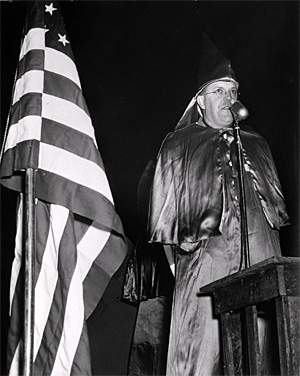
Thomas L. Hamilton, Grand Dragon of the Association of Carolina Klans (AP/WideWorld Photo)
Carter was visited twice, in fact, by the Klan's Grand Dragon,
Thomas L. Hamilton, who warned the young editor: "You can't exist
if we [the Klan] are put out of business, because before we go
out of business, we'll have every one of our members to stop
reading your paper. And I'll go talk to every advertiser you've
got in town and tell them they are not to advertise in your paper."
And if the advertisers complied, Carter recalled, the Tribune
was sunk: "[A]nybody that's acquainted with small town weekly
newspapers knows that a half a dozen people, or a dozen,
can boycott your advertising sales, and you're out of business."
Similar threats and warnings were issued to Carter’s
principal public ally, Willard Cole, who became particularly
aggressive in campaigning against the Klan. Indeed, as the
editor of the twice-weekly Whiteville News Reporter, which
had nearly three times the number of subscribers as Carter’s
weekly Tribune, Cole became the man most despised and reviled
by the Klan.
The Klan actions that drew the most sustained attention from Carter
and Cole— as well as from the FBI, the State Bureau of Investigation,
and local law enforcement officials—were the floggings that occurred
in Columbus and Horry counties between 1950-52. Of the 13 floggings
attributed to klansmen during this time—and there were many, many more
that went unreported to authorities, especially in Horry County—only
3 of the victims were black. What was more, all 13 victims—including
the African Americans—were reportedly punished for at least one alleged
moral crime such as adultery, physical abuse, child neglect, not attending
church, excessive drinking, or making moonshine.
Prison and Pulitzer
In February of 1952, the FBI arrested 10 klansmen on charges
of kidnapping an unmarried white couple from their home
in Fair Bluff, N.C., and then transporting the two across
the state line into South Carolina, where they were flogged.
The FBI action set off a wave of arrests for the other floggings,
mostly on state charges, and nearly a hundred former klansmen,
including Thomas L. Hamilton, were eventually tried and
convicted in connection with the floggings.
Gold medals for the Pulitzer Prize for Meritorious Public
Service were awarded to the Tribune and the Whiteville News
Reporter in May of 1953 for the anti-Klan crusade waged
by their respective editors, Horace Carter and Willard Cole.
Although Cole left his job just nine months later, in an
effort to pursue other opportunities, he eventually returned
to the newspaper business in Lumberton, N.C., where he died,
in 1965, at the age of 58.
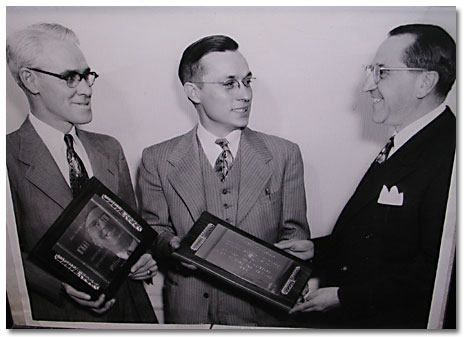
Willard Cole, left, and Horace Carter, center, receive B’nai
B’rith’s First Annual Southeastern United States
Plaque for Public Service
Horace Carter received numerous
state and national awards in addition
to the Pulitzer, and in 1954, in addition to being elected
mayor of Tabor City, he and Lucile celebrated the birth
of their third child, Velda Kay. He and Mark Garner also
continued to buy and print newspapers through Atlantic Publishing.
After acquiring two South Carolina newspapers in 1952, the
Conway Field and Loris Sentinel, they
purchased a third in 1953, the Ocean Beach News, which in
1954 was merged with the Myrtle Beach Sun. By the late 1950s,
the company was printing nine different newspapers and finding
it increasingly difficult to coordinate the diversity and
dispersal of its holdings. In 1957, Garner bought the Myrtle
Beach Sun from Atlantic Publishing and founded the Sun Publishing
Co., which in 1961, purchased the Myrtle Beach News and
merged it with the Sun to form the Sun-News.
Carter continued to edit and publish the Tribune and to
run Atlantic Publishing until the 1970s, when he moved to
Cross Creek, Florida, and left management of the company
to his son Rusty. By then, both of Carter’s oldest
children, Linda and Rusty, had graduated from UNC, while
his youngest child, Velda Kay, had become a student there.
Carter continued writing for the Tribune while living in
Florida but found a successful second career writing books
about hunting and fishing and selling stories to outdoor
living magazines. Following the death of his wife Lucile
in 1981, Carter married Brenda Strickland and began what
he later described as “the most productive time in
my life as I wrote fourteen more books and another thousand
articles during the twelve years that we were married.”
Divorced from his second wife in 1994, Carter returned to
Tabor City and to full-time work at the Tribune. In 1995,
Carter married his third wife, Linda Duncan Moore. The couple
continues to make their home in Tabor City, where Carter
still works and writes for the Tribune.
|
|
